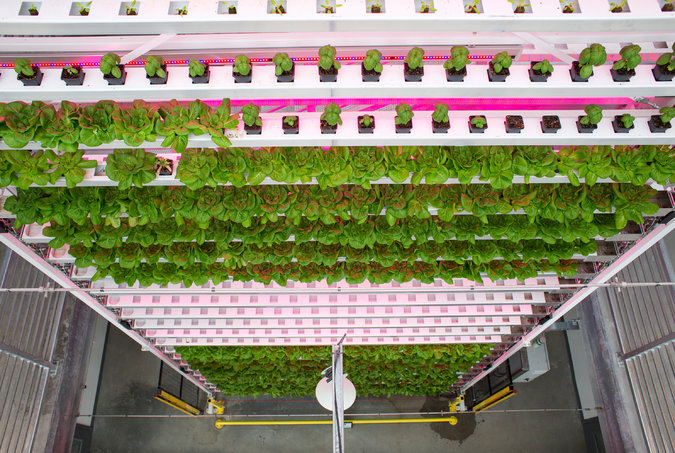By Claire Martin
The Wyoming soil, iced over for eight months of the year, is not particularly hospitable to heirloom tomatoes, baby basil or lettuce plants. Instead, vegetables are trucked in from California, Mexico and other more fecund parts of the world. Yet starting this spring, Vertical Harvest, a farm in the resort town of Jackson, will begin churning out a projected 100,000 pounds of fresh produce a year. Vertical Harvest uses hydroponic farming methods inside a three-story greenhouse on a 4,500-square-foot downtown lot. It is engaging in a relatively new practice called vertical farming. The company employs 15 people who have conditions such as Down syndrome, autism, seizure disorders and spina bifida; they share 140 hours of work a week under a customized employment model. Vertical Harvest is a public-private partnership with the town of Jackson and it uses a low-profit business model, which means its investors will see a modest profit and it won’t come quickly.
“We’ve been calling it patient capital,” says Penny McBride, a company founder and its chief operating officer.
The farm began growing tomatoes in December and lettuce and herbs in February. By early May, Vertical Harvest’s greenhouse will be fully planted and producing greens. It will distribute them to restaurants and sell them at local grocery stores and in a retail market, inside the greenhouse, which opened this month.
The idea for Vertical Harvest came roughly eight years ago, around the time Ms. McBride and Nona Yehia met at a party in Jackson. Ms. McBride was a consultant working on a food-waste study and a commercial composting start-up, among other projects, and Ms. Yehia was an architect at the local firm E/Ye Architects who had recently designed a public rock climbing park and a private greenhouse that could withstand the harsh Wyoming winters.
The women were aware of the rising demand for high-quality, locally grown produce. Spurred by the organic and farm-to-table culinary movements, droves of professional chefs and home cooks had begun searching out better produce.
Farmers’ markets have responded to the challenge of meeting the need. Their numbers increased by 180 percent from 2006 to 2014, according to a government report. But they can’t do it all. Vertical farms are helping fill the produce gaps, according to Dickson Despommier, author of the book “The Vertical Farm: Feeding the World in the 21st Century.” He said there were 30 such farms in the United States and hundreds more worldwide. Japan, with 160, leads the field.
“I don’t know any commercial vertical farms that are not in expansion mode,” Mr. Despommier said.
Vertical Harvest stands out for its relatively small size. The two largest vertical farms in the United States are Green Sense Farms, a 30,000-square-foot hydroponic operation in Portage, Ind., and AeroFarms, an aeroponic greenhouse in Newark whose footprint is a whopping 69,000 square feet. In aeroponic farming, the plants’ roots are exposed to the air, instead of water, as they are in hydroponic farming.
Mr. Despommier said that demand for produce cultivated in vertical farms was also growing because of the desires to create self-sufficient food sources without relying on imports and to ensure food safety. The market is so strong that the vegetables practically sell themselves, he said.
“If you don’t make money, it’s because you don’t know how to add,” he said.
But initially, Vertical Harvest wasn’t an easy sell to some Jackson residents. When Ms. Yehia and Ms. McBride first pitched their idea to the town, which owns the land and the building that Vertical Harvest occupies, they were competing against other proposals. These included a dog park and affordable housing units.
We had to prove it was a feasible idea that would have enough community impact for the town to essentially lease us the land for free,” said Ms. Yehia, the company’s chief executive. (Vertical Harvest pays $100 a month in rent.)
Once their proposal beat the others, the women were required to make their business plan public. And when they needed approvals along the way for things like the lease agreement, they had to make presentations at Town Council meetings.
“At every step of the process we checked in with the town,” Ms. Yehia said.
At first Ms. Yehia and Ms. McBride planned to fund the project exclusively with grant money. But their costs kept rising because of unforeseen complications connected to the vertical nature of the greenhouse. They realized they would need to hire a structural engineer, for one thing.
As soon as you go up, you start having different considerations in terms of the seismic code and the life safety code,” Ms. Yehia said.
Construction costs also rose. “Our greenhouse manufacturers hadn’t dealt with a vertical greenhouse before, so their original estimates in some cases doubled,” Ms. Yehia said.
She and Ms. McBride began raising money, eventually taking in $3.8 million in public and private funding.
Among the company’s detractors was Ed Cheramy, a retired businessman who served as vice president of the Jackson branch of the Tea Party. His objections involved the objectives of his organization: free markets, and limited and fiscally responsible government.
“Should government be investing money or spending money to do a speculative venture like this?” he said he asked at the time. “Should the government be sponsoring an organization that would compete with the private sector?”
Mr. Cheramy said he stood up at a Town Council meeting in which Ms. Yehia’s and Ms. McBride’s proposal was being discussed and “complained about them and pointed out all of what I thought to be inadequacies of their business plan.” Afterward, the two women asked to meet with him to talk about his concerns — a move that he said surprised him. But he agreed to talk.
They met weekly for several months to work through the business plan. Mr. Cheramy said he quickly understood that Vertical Harvest would not be competing with any local businesses, and he was impressed that Ms. Yehia and Ms. McBride had already secured a revenue stream. They had sold 95 percent of their projected crop output to restaurants and grocery stores and would set aside 5 percent to sell in their retail store.
Of their willingness to hear their opponents’ concerns, Ms. Yehia said, “We have extremely thick skin.”
Eventually, Mr. Cheramy found he had no choice but to support the project. “When you strip away all of your objections, and they’d done all that, then what you’re left with is support,” he said. He added that he testified on behalf of Vertical Harvest at the Jackson Town Council, and at the Wyoming Business Council and the Wyoming State Loan and Investment Board, which together gave the project a $1.5 million grant.
“There’s a whole bunch of wonderful aspects of it,” Mr. Cheramy said, noting Vertical Harvest’s tall and narrow greenhouse design and its hiring of people with disabilities. “But it also makes good fiscal sense.”



